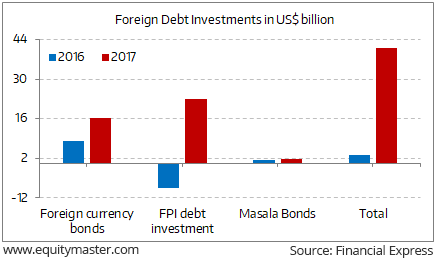Stock markets in India are presently trading marginally higher. Sectoral indices are trading on a negative note with stocks in the oil & gas sector and healthcare sector witnessing maximum selling pressure.
The BSE Sensex is trading down 36 points (down 0.1%) and the NSE Nifty is trading down 2 points (down 0.01%). The BSE Mid Cap index is trading down by 0.5%, while the BSE Small Cap index is trading down by 0.4%. The rupee is trading at 63.65 to the US dollar.
In the news from the bond markets, as per a leading financial daily, the government said today that the 8% Savings Bonds Scheme is not closed and is instead been replaced by 7.75% Savings Bonds Scheme.
Reports had earlier said that the government will stop subscription for the 8% Savings Bonds Scheme, also known as RBI Bonds Scheme, with effect from January 2.
These Government of India bonds come with a lock-in period of six years and fetch a rate of interest of 8% per annum, compounding on a half-yearly basis. With bank deposit rates falling lately, the 8% Savings Bonds Scheme stood a preferred choice for those looking for a regular guaranteed income.
Speaking of bond markets, note that the bond market in India is witnessing a strong revival.
Foreign debt raised by Indian companies has surged ten-fold to US$ 41 billion in 2017. This is the highest ever infusion of foreign funds in the domestic debt markets in the last 15 years.
At US$ 23 billion, foreign investments in government securities and corporate paper took the cake. This was followed by dollar denominated bonds that attracted around US$ 16 billion of foreign investments whereas funds of US$ 2 billion were mopped up by masala bonds. Masala Bonds are rupee-denominated borrowings by Indian entities in the overseas markets.
All this has made the Indian bond market flush with foreign debt investments lately, as can be seen from the chart below:
Bond Markets on a High
Apart from the above, the recent sovereign rating upgrade by Moody's coupled with factors such as economic stability, abundant global liquidity and diversification needs of investors have stoked demand for Indian bonds in the overseas markets.
In the news from global financial markets, as per Reuters, Asia's factories ended the year 2017 on a mixed note.
This came as activity was seen at multi-year highs in Taiwan and India and surprisingly picking up in China, but contracting in some places amid expectations that regional interest rate hikes likely will be gradual.
In China, manufacturing growth picked up to a four-month high in December amid a surge in new orders. Taiwan also saw manufacturing activity hitting its highest since April 2011 at 56.6 last month, according to a December survey.
Singapore, however, posted slower economic growth in the fourth quarter than the third as manufacturing shrank 11.5% following an 38% jump in the previous three months.
As for the Indian economy, the Nikkei/Markit survey for December showed factory activity expanded at the fastest pace in five years. This came on the back of a rise in output and new orders, which allowed firms to raise prices.
It would be interesting to see how the factory activity pans out in 2018 for the above economies. We will keep you updated on the developments from this space.
This article was originally published in English at www.equitymaster.com
Read the complete Indian stock market update. For the terms of use, go here.

No comments:
Post a Comment